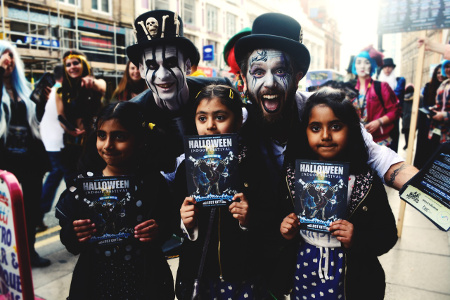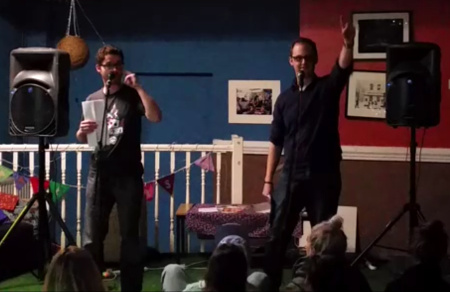Reflections on the NUS and police following the ‘Siege of Milbank Court’
Article published: Friday, November 12th 2010
An assessment of the potential political implications for the NUS and reasons for police behaviour following the siege of Milbank Court
At either sides of the spontaneous energy and rage of students who broke away from the main NUS march yesterday to smash and besiege Tory HQ there are two forces pulling in opposite directions: the NUS and the police. In this short analysis I will look at what the fallout from yesterday’s action could entail.
The NUS is a tame beast which never does much more than purr from within its cage. But it is well-fed and gets a pat on the head from its master from time to time, so President Aaron Porter’s immediate reaction – a vitriolic condemnation of the ‘minority’ of troublemakers responsible for the action – was predictable. Ignoring the separate argument of the legitimacy of the action as a form of self-expression and reclaiming democracy, it is worthwhile looking at what could be the consequences.
There appear to be two possible outcomes for the NUS and whichever route they take depends on how they spin yesterday’s events and their behind-the-scenes politicking with establishment figures. Either the government and Labour will choose to blame the actions on them – due to their inability to control their own ranks – and refuse to listen to them , thereby pissing on their fantasy of being able to wrangle concessions out of the government by getting down on their knees and begging.
Or, as appears more likely, the NUS will use the unforeseen ‘rogue elements’ to their advantage: by presenting themselves to the government as the moderate force in the student body, they could strengthen their negotiating position as the alternative to more angry scenes. For they will be able to approach the government with the implicit threat – ‘take this seriously, or there is more of this around the corner’. And their hope will be that once they are seen by the majority of students to have some leverage with the government, they will be able to prod back into line those ‘normal’ students who obeyed their instincts and participated in yesterday’s rout.
The police response to the siege was a strange one by their standards and deserves some reflection and analysis. During the insurrection their response was an extremely muted one and there was none of the brutality or heavy-handed violence we have come to expect at political demonstrations in recent years. In front of Milbank court they seemed content to hold their line rather than advance; and they made minimal arrests considering the numbers engaged in smashing the building. The only scene of any real confrontation that I saw was at the back entrance to the building when they aggressively forced out around 40 people from the internal staircase – but even then they did not grab and arrest anybody. Compared with the testosterone-fuelled brutality of G20 the police looked a forlorn and unconfident lot, unsure of their territory and clearly without a mandate to indiscriminately batter.
There are three possible explanations for this. The most straight-forward is that they were simply caught off-guard by the direct action because, given the pacific character of NUS-led demos in recent times, there were no grounds for suspecting such an uprising. Yet even if this was the case their response – or lack thereof – was suspect. Granted they quickly responded with a line of riot cops to defend Lib Dem HQ but there was no concerted made to clear Milbank court or, as many of us feared, to kettle the entire area in. Again, the use of kettling – where protestors are in effect trapped in a given geographical space for up to several hours at a time – has proven politically contentious, but according to cop logic it would be justified in such a situation.
Another explanation is that the leadership were under political pressure from above to avoid highly confrontational scenes. Policing of demonstrations has been under intense scrutiny since a Met officer killed bystander Ian Tomlinson at the G20 protests in April 2009. All you have to ask yourself here is how would a government with faltering popularity and now under literal attack by a sector of the population look when it sends in amour-clad pigs to baton sixth-form pupils?
But a more interesting interpretation of this apparently calm response would be that the police were sending out a tacit political message to the government. For the first time in living memory the police are to see their funding slashed and recruitment frozen as part of the government’s cuts. For stalwart Conservatives – the party of law and order – this is unthinkable; and for the police this must feel like the breaking of an age-old covenant between the boys in blue and the boys with blue ties. In September the Police Superintendents Association issued a clear warning over cuts to their funding, stating how they would be increasingly needed to defuse industrial and social unrest in times of austerity. But as they were not spared the axe in the last month’s Spending Review, this reading would state that the police deliberately remained hands-off in a stark warning to the government: cut our funding and resources and you can expect more of this.
While this theory may have a somewhat conspiratorial air to it, the police press release in aftermath lends it credence, with the Met reiterating the message that the events underlined the need for a strong police force in the face of cuts and its subsequent unrest. Furthermore this is not the first example we have seen of a softly-softly approach to public order incidents in recent weeks. Last month environmental activists blockaded an access road to two oil refineries in Coryton, Essex, which provides 22% of the UK’s forecourt petrol. Although managing to wrong-foot the police was again a massive coup pulled off by organisers, the police response was a visibly cagey one: they neither made any real effort to clear the tripods and blockades which covered the road, nor did they make any arrests. In another unreported incident which I have been told of by only by mouth, police not only allowed a free party near Oxford Road in London to take place at Halloween, but were actually directing revellers to its location.
Whether these are part of a trend is hard to say but it certainly appears more than coincidence. But for those who will be involved in antagonistic social struggles in the months to come we cannot let this recent lassitude let us be complacent or unprepared for confrontation; for once the police feel they have got what they deserve, they will strike back at ‘lawbreakers’ and ‘troublemakers’ with a vengeance.
Chiming a similar note to Aaron Porter there was the expected admission by Met Chief Sir Paul Stephenson that the event was an ‘embarrassment’ to the force. Yet for neither is the self-loathing repent sincere: both appear merely to be going through the motions – stating publicly what is required of them, while realising that there are social forces beyond their control and which they can only hope to manipulate for their own ends.
In sum the ironic outcome of yesterday was that effectively the same message was conveyed to the government by all three forces involved – the NUS, the police and the autonomous students at the heart of the events: this is just the beginning. And while they were for manifestly different purposes and ends, we need to make sure that there will be more to come.
James Cassidy
More: Blog
Comments
No comments found
The comments are closed.



